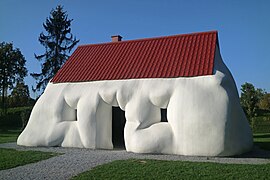Erwin Wurm
This article has multiple issues. Please help improve it or discuss these issues on the talk page. (Learn how and when to remove these template messages)
|
Erwin Wurm | |
|---|---|
 (2014) | |
| Born | 27 July 1954 |
| Nationality | Austrian |
| Education | University of Applied Arts Vienna |
| Known for | Sculpture, photography |
| Notable work | Fat Car series |
| Awards | Grand Austrian State Prize 2013 |
Erwin Wurm (born 1954) is an Austrian artist born in Bruck an der Mur, Styria, Austria. He lives and works in Vienna and Limberg, Austria.[1]
Early life and education
This section needs expansion. You can help by adding to it. (July 2015) |
Philosophy
In The Artist Who Swallowed the World, Wurm is quoted as saying: "I am interested in the everyday life. All the materials that surrounded me could be useful, as well as the objects, topics involved in contemporary society. My work speaks about the whole entity of a human being: the physical, the spiritual, the psychological and the political."
Wurm is known for his humorous approach to formalism.[1] About the use of humor in his work, Wurm says in an interview: "If you approach things with a sense of humor, people immediately assume you're not to be taken seriously. But I think truths about society and human existence can be approached in different ways. You don't always have to be deadly serious. Sarcasm and humor can help you see things in a lighter vein."[2]
Although the images are slightly humorous, they extend or manipulate reality in ways that can be disturbing. Wurm's work portrays manipulated images of things in everyday life, things that look familiar, but which become distorted. Pieces like Truck, where a truck curves up against the building or Narrow House, a thin, claustrophobic house, take something familiar to all and distort it by enlarging, curving it, or slimming it down. “I will often use humor to seduce people”, admits Wurm. “To get them to move closer, but it’s never very nice when they look closer."
Wurm's work is often critical of Western society and the mentality and lifestyle of his childhood during post-World War II Austria. Although Wurm's sculptures are humorous and ridiculous, they are actually quite serious. His criticism is playful, but should not be confused with kindness.[3] He represents his criticism of objects, such as clothing, furniture, cars, houses, and everyday objects to his audience. Common themes in his work include not only our relationship to banal everyday objects, but also philosophers and life in postwar Austria.
In talking about his often-mentioned topics of the gaining and losing of body weight and philosophy, Wurm stated: "It's about the difficulty to cope with life. Whether with diet or with a philosophy".[4] What is being talked about here is how diet and philosophy are two parts of our daily lifestyle: on the one hand physically and on the other hand spiritually. In the context of the quote, this "diet" could concern cars or clothes or food: a diet in which you consume too much ensures that you will exist in excess. His bloated works speak to the way people buy things that symbolize high status with which they manage their life. But his work also deals with philosophy by focusing on philosophers who lived in the time of the early twentieth century.
One Minute Sculptures
Since the late 1980s, he has developed an ongoing series of One Minute Sculptures, in which he poses himself or his models in unexpected relationships with everyday objects close at hand, prompting the viewer to question the very definition of sculpture.[5] He seeks to use the "shortest path" in creating a sculpture—a clear and fast, sometimes humorous, form of expression. As the sculptures are fleeting and meant to be spontaneous and temporary, the images are only captured in photos or on film.
To make a One Minute Sculpture, the viewer has to part with his habits. Wurm's instructions for his audience are written by hand in a cartoon-like style. Either Wurm himself or a volunteer follow the instructions for the sculpture, which is meant to put the body in an absurd and ridiculous-looking relationship with everyday objects. Whoever chooses to do one of Wurm's One Minute Sculptures holds the pose for a minute, or the time it takes to capture the scene photographically. These positions are often difficult to hold; although a minute is very short, a minute for a One Minute Sculpture can feel like an eternity.
Fat Car series
Wurm believes the creation of sculpture is adding and subtracting material to an object.[6] In his works, he does so by layering clothes over each other, or items represented as fat, obese, or inflated.
Wurm has worked on a series of sculptures titled Fat Car, which depict "puffy, obese, life-size sculptures that bulge like overfilled sacks".[7] The first of his Fat Car series was developed with Opel designers, but they were unsuccessful in achieving the kind of shape that Wurm had in mind. In order to create the desired look of fatness, the artist uses polyurethane foam and styrofoam covered with lacquer. Wurm has also produced a Fat House at near full scale.
His “fat” works of art are meant to critique consumer culture and Western culture's need for material objects. Wurm once noted that many people are obsessed with having bigger houses and bigger cars, which is exactly what he creates in these pieces. However, his cars and Fat House are not big in a sense that people are drawn to. Although these pieces look ridiculous and funny, there is very pointed criticism behind them about how ridiculous and funny the owners of such things are to the artist.
Narrow House
Erwin Wurm "shrank" his parents' house to reflect the mentality of Austria during the postwar period; the design of the house is typical of the 1950s, but a fraction of the width. The house is furnished with shrunken furniture. This piece was inspired by Wurm's childhood, since he grew up during the 1950s through 1970s in postwar Austria. Growing up, he lived with his parents; his mother stayed at home and his father was a policeman.[8] Therefore, it was difficult to express himself both at school and at home. This limited view has affected Wurm's philosophy of art strongly, and Narrow House is a physical manifestation of it. When the viewers walk through, they feel the tension and claustrophobia that Wurm experienced on a daily basis as a child.
From Men's Size 38 to Size 48 in Eight Days
Erwin Wurm's displayed work From Men’s Size 38 to Size 48 in Eight Days are pages from his instruction book that explains Wurm's daily diet and activities each day in order to increase his body mass tremendously over the week.[9] The book contains short advice such as, “day nap”, “breathe deeply”, “read or lay near an open window”.[9] The mounted photos also include various advice, from meal content to room temperature, in order to expedite extreme weight gain.[10] Many of the unhealthy meal plans include things like, “two bottles of beer for lunch, one litre of red wine for dinner, and rich Austrian sweet recipes, like scheiterhaufen (also known as Žemlovka) , as a full-on course”.[9] Wurm believes that gaining or losing weight is a medium of sculptural work.[11] Similar to his One Minute Sculptures, Erwin Wurm uses the human body to provide the material to make this sculpture.[12] The artist's intention for the audience is to feel as if their bodies are filled with the food from reading the instruction book and become the sculptures themselves.[9] It serves as a comeback to self-help books that idealize a slender, healthy body.[12] Wurm's artistic process of utilizing the human body with the live-action event as a medium, serves as a fundamental meaning-making practice for artists all over the world.[13]
Cultural influences
In the Red Hot Chili Peppers 2003 music video "Can't Stop" the members of the band carry out five of Wurm's One Minute Sculptures. At the end of the video, a sign states that Wurm was an inspiration for the video. In a recent iTunes interview, Flea is quoted as saying Wurm's picture of a man with a pencil in his nose was a significant influence on the video (Flea himself appears in the video, at a certain point, with markers in his nostrils, pencils in his ears, and paint pot caps over his eyes). Due to the popularity of the video, Wurm's work also boomed in popularity.[citation needed]
Collections and exhibitions
Erwin Wurm's works are in collections worldwide, including the Solomon R. Guggenheim Museum, Peggy Guggenheim Collection, Walker Art Center, Museum Ludwig, Kunstmuseum St. Gallen, Musée d'art contemporain de Lyon, Museum of Old and New Art, and the Centre Pompidou.[1]
Gallery
-
Bunker (1987)
-
Gurken (Pickles)
-
Installation at Museum Moderner Kunst Stiftung Ludwig Wien
-
Detail of inverted house
-
Installation at Hotel Daniel, Vienna, Austria
-
Closeup of Hotel Daniel installation
-
Detail of Hotel Daniel installation
-
Installation at a canal lock near Nantes, France
-
Fat Car (2001)
-
Fat House (2003)
-
Sculpture, Votivkirche, Vienna, 2012
-
Lenten veil by Erwin Wurm at St. Stephen's Cathedral in Vienna, Austria (2020)
Further reading
- Davila, Thierry; Fleck, Robert; Kunde, Harald; Wurm, Erwin (2006). The artist who swallowed the world: Erwin Wurm (2 ed.). Ostfildern: Hatje Cantz. ISBN 9783775718660.
- Friedel, Helmut; Schuh, Franz; Stephan Berg, Stephan; Wurm, Erwin (2009). Erwin Wurm. Cologne: DuMont. ISBN 978-3832192594.
- Dünser, Hans (2011). Erwin Wurm: Narrow house (1 ed.). Nürnberg: Verlag für Moderne Kunst. ISBN 978-3869842455.
- Soikkonen, Sarianne (2015). Erwin Wurm: Disruption. Tampere: Sara Hildén Art Museum. ISBN 978-951-609-768-1.
References
- ^ a b c "Lehmann Maupin". Lehmannmaupin.com. Retrieved 20 January 2015.
- ^ Wurm, E (2007). "Pretty Cool People Interviews: Erwin Wurm", SubmarineChannel.
- ^ "Erwin Wurm and The Standard: How the notorious Austrian artist inspired a collaboration unlike any we've done before". The Standard. 3 October 2012. Archived from the original on 31 December 2014. Retrieved 20 January 2015.
- ^ "Musik & Extase : Die Wagner-Ausstellung" (PDF). Wagner200.com. Retrieved 2015-04-09.
- ^ "'One Minute Sculptures' Invade the Schindler House". ArtsBeat. Retrieved 2016-03-12.
- ^ "Art Review : January & February 2011" (PDF). Images-exhibit-e.com. Retrieved 2015-04-09.
- ^ Patton, Phil (2 April 2010.) 'Cars Starved (or Stuffed) for Attention', The New York Times
- ^ "Kテシnstlergesprテ、ch: Erwin Wurm zu "Narrow House"". YouTube.com. Retrieved 20 January 2015.
- ^ a b c d PCL, Post Publishing. "Bangkok Post article". Bangkok Post. Retrieved 2021-04-09.
- ^ "Walk Through Erwin Wurm's Berlin Show". Artnet News. 2016-04-19. Retrieved 2021-04-09.
- ^ "You too can be a sculpture". www.nationthailand.com. Retrieved 2021-04-09.
{{cite web}}: CS1 maint: url-status (link) - ^ a b Artdaily. "Berlinische Galerie presents Erwin Wurm's first monographic exhibition at a Berlin museum". artdaily.cc. Retrieved 2021-04-09.
- ^ Intili, Amanda; Pembleton, Matthew; Lajevic, Lisa (2015-05-01). "Defying Reality: Performing Reimagined Worlds". Art Education. 68 (3): 40–46. doi:10.1080/00043125.2015.11519321. ISSN 0004-3125.
External links
- Official Website
- Interview, recorded on 2007-09-06
- Erwin Wurm at Xavier Hufkens, Brussels
- Artnet: Erwin Wurm
- MCA Sydney, Australia: Erwin Wurm
- Erwin Wurm: Greatest Human Being Who Ever Lived
- Erwin Wurm
- Lehmann Maupin Gallery
- Galleri Bo Bjerggaard
- Red Hot Chili Peppers - Can't Stop - A clip which ispired by the one minute sculptures












